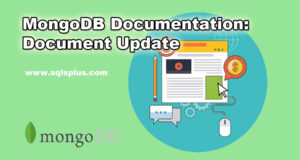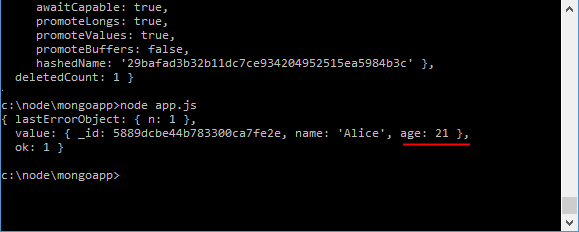REQUEST COMPLIMENTARY SQLS*PLUS LICENCE
MongoDB Documentation: Document Update

MongoDB Documentation – There are several methods to update Document in MongoDB:
- updateOne: refreshes one document that meets the filtering criteria and returns information about the update operation
- updateMany: refreshes all documents that meet the filtering criteria and returns information about the update operation
- findOneAndUpdate: refreshes one document that meets the filter criteria and returns an updated document.
findOneAndUpdate
The findOneAndUpdate() method updates one element. It accepts the following parameters:
- The criterion for filtering the document to be updated
- Update option
- Additional update options, which are null by default
- The callback function that is performed during an update
For example, let’s update the first user in the database who is 21 years old:
const MongoClient = require("mongodb").MongoClient;
const url = "mongodb://localhost:27017/";
const mongoClient = new MongoClient(url, { useNewUrlParser: true });
let users = [{name: "Bob", age: 34} , {name: "Alice", age: 21}, {name: "Tom", age: 45}];
mongoClient.connect(function(err, client){
if(err) return console.log(err);
const db = client.db("usersdb");
const col = db.collection("usersdb");
col.insertMany(users, function(err, results){
col.findOneAndUpdate(
{age: 21}, // sampling criterion
{$set: {age: 25}}, // update parameter
function(err, result){
console.log(result);
client.close();
}
);
});
});
At first, 3 users shall be added to the database, and after the addition is updated.
The object { $set shall be used for updating: object {age: 25}}. The $set parameter shall update the values for a single field or group of fields. In this case, the age field shall be changed.
The third parameter, the callback function, displays the update result. By default, this is the old state of the modified document:

But, let’s say, after the update, we want to get not the old but the new state of the modified document. To do this, we can specify additional update options.
const MongoClient = require("mongodb").MongoClient;
const url = "mongodb://localhost:27017/";
const mongoClient = new MongoClient(url, { useNewUrlParser: true });
mongoClient.connect(function(err, client){
if(err) return console.log(err);
const db = client.db("usersdb");
const col = db.collection("usersdb");
col.findOneAndUpdate(
{name: "Bob"}, // sampling criterion
{$set: {name: "Sam"}}, // update parameter
{ // additional update options
returnOriginal: false
},
function(err, result){
console.log(result);
client.close();
}
);
});
updateMany
The updateMany() method allows you to update all documents in the collection that meet the filtering criteria:
const MongoClient = require("mongodb").MongoClient;
const url = "mongodb://localhost:27017/";
const mongoClient = new MongoClient(url, { useNewUrlParser: true });
mongoClient.connect(function(err, client){
if(err) return console.log(err);
const db = client.db("usersdb");
const col = db.collection("usersdb");
col.updateMany(
{name: "Sam"}, // filter criterion
{$set: {name: "Bob"}}, // update parameter
function(err, result){
console.log(result);
client.close();
}
);
});
updateOne
The updateOne() method is similar to the updateMany method except that it updates only one element. Unlike the findOneAndUpdate() method, it does not return a modified document:
const MongoClient = require("mongodb").MongoClient;
const url = "mongodb://localhost:27017/";
const mongoClient = new MongoClient(url, { useNewUrlParser: true });
mongoClient.connect(function(err, client){
if(err) return console.log(err);
const db = client.db("usersdb");
const col = db.collection("usersdb");
col.updateOne(
{name: "Tom"},
{$set: {name: "Tom Junior", age:33}},
function(err, result){
console.log(result);
client.close();
}
);
});
Database, Collections, Documents: MongoDB
MORE NEWS
PreambleNoSql is not a replacement for SQL databases but is a valid alternative for many situations where standard SQL is not the best approach for...
PreambleMongoDB Conditional operators specify a condition to which the value of the document field shall correspond.Comparison Query Operators $eq...
5 Database management trends impacting database administrationIn the realm of database management systems, moreover half (52%) of your competitors feel...
The data type is defined as the type of data that any column or variable can store in MS SQL Server. What is the data type? When you create any table or...
PreambleMS SQL Server is a client-server architecture. MS SQL Server process starts with the client application sending a query.SQL Server accepts,...
First the basics: what is the master/slave?One database server (“master”) responds and can do anything. A lot of other database servers store copies of all...
PreambleAtom Hopper (based on Apache Abdera) for those who may not know is an open-source project sponsored by Rackspace. Today we will figure out how to...
PreambleMongoDB recently introduced its new aggregation structure. This structure provides a simpler solution for calculating aggregated values rather...
FlexibilityOne of the most advertised features of MongoDB is its flexibility. Flexibility, however, is a double-edged sword. More flexibility means more...
PreambleSQLShell is a cross-platform command-line tool for SQL, similar to psql for PostgreSQL or MySQL command-line tool for MySQL.Why use it?If you...
PreambleWriting an application on top of the framework on top of the driver on top of the database is a bit like a game on the phone: you say “insert...
PreambleOracle Coherence is a distributed cache that is functionally comparable with Memcached. In addition to the basic function of the API cache, it...
PreambleIBM pureXML, a proprietary XML database built on a relational mechanism (designed for puns) that offers both relational ( SQL / XML ) and...
What is PostgreSQL array? In PostgreSQL we can define a column as an array of valid data types. The data type can be built-in, custom or enumerated....
PreambleIf you are a Linux sysadmin or developer, there comes a time when you need to manage an Oracle database that can work in your environment.In this...
PreambleStarting with Microsoft SQL Server 2008, by default, the group of local administrators is no longer added to SQL Server administrators during the...
















